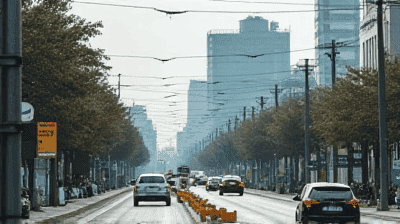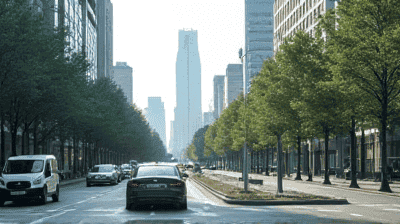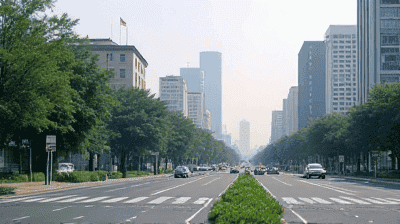
Traffic noise pollution has become an unavoidable byproduct of urbanization and increased vehicular use in our cities. As populations grow and transportation networks expand, concerns over the impact of traffic noise on public health, well-being, and the environment have escalated. Prolonged exposure to high levels of noise pollution has been linked to various negative health outcomes, including stress, sleep disturbances, and cardiovascular issues.
Traffic noise pollution refers to the unwanted or harmful levels of noise generated by vehicles on roads, highways, and railways. This type of pollution is characterized by sounds generated from:
Vehicles: Cars, trucks, buses, and motorcycles contribute to noise levels through engine sounds, tire friction, and the operation of horns.
Transportation Infrastructure: Highways, railways, and airports also generate significant noise pollution, particularly in areas located near these facilities.
Traffic Volume: Increased traffic volume results in higher noise levels, with rush hours often leading to temporary spikes in sound.
The negative health effects of traffic noise pollution have been widely documented. Key impacts include:
Sleep Disturbances: Continuous exposure to high noise levels can disrupt sleep patterns, leading to diminished overall health and increased fatigue.
Stress and Anxiety: Chronic noise pollution can elevate stress levels and lead to anxiety-related disorders, impacting mental health.
Cardiovascular Problems: Numerous studies have linked long-term exposure to noise pollution with cardiovascular issues, including hypertension and heart disease.
Impairment of Communication: In environments with high noise levels, effective communication can be hampered, leading to frustration and misunderstanding among individuals.
Reduced Quality of Life: Overall, the presence of persistent traffic noise can diminish residents' enjoyment of their homes and neighborhoods, reducing satisfaction with the living environment.

Noise barriers, also known as sound walls or sound barriers, are structures designed to block or deflect sound waves generated by traffic, industrial activities, or other sources of noise pollution. These barriers are typically constructed alongside highways, railways, or major roads to protect residential areas from excessive noise.
Several types of noise barriers can be employed depending on the specific noise reduction needs and the environmental context:
Acoustic Walls: Built from solid materials such as concrete, masonry, or wood, acoustic walls effectively absorb and reflect sound waves, minimizing noise intrusion.
Earth Berms: These are earthen mounds designed to act as natural sound barriers. Employed for their aesthetic appeal, earth berms can blend into the landscape while effectively reducing noise.
Reflective Barriers: Constructed with materials designed to reflect sound away from residential areas, reflective barriers can reduce noise levels effectively.
Living Walls: These barriers incorporate vegetation in their design, contributing to noise reduction while enhancing biodiversity and improving air quality.
Noise barriers function based on the principles of sound wave propagation and reflection. Key mechanisms include:
Sound Absorption: Noise barriers absorb sound energy, diminishing the intensity of noise that reaches nearby areas.
Reflection: Barriers can redirect sound waves away from residential zones, minimizing the amount of noise that enters these spaces.
Diffraction: Barriers disrupt the path of sound waves, causing them to bend around the structure and reducing noise levels in the areas beyond.
The effectiveness of noise barriers depends on several factors, including:
Height and Length: Taller and longer barriers provide greater noise reduction, as they obstruct the direct line of sight between the noise source and the affected area.
Material Properties: The density and composition of the materials used in constructing the barrier determine its sound-absorbing and reflecting capabilities.
Location: The placement of the barrier relative to noise sources and sensitive areas (such as hospitals and schools) influences its overall effectiveness.
Numerous cities and regions have implemented effective noise barrier projects. Notable examples include:
Los Angeles, California: The city has constructed extensive noise barriers along its highways to protect residential neighborhoods from traffic noise, significantly improving the quality of life for residents.
Berlin, Germany: In response to increasing urban noise, Berlin has employed innovative noise barriers, incorporating green spaces and vegetation to enhance aesthetic appeal while reducing noise levels.
Tokyo, Japan: Tokyo has implemented a network of sound walls along major roadways and railways, showcasing advanced technology and design to combat noise pollution in densely populated areas.
Urban planning is the process of designing and regulating land use and development in urban areas to create sustainable and livable communities. It encompasses a range of activities, including zoning, transportation planning, environmental management, and community development.
Zoning Regulations: Implementing zoning regulations can minimize noise exposure by separating residential areas from high-traffic zones. Buffer zones, such as commercial and industrial districts, can further protect residential communities from noise pollution.
Mixed-Use Development: Promoting mixed-use development can help reduce traffic volumes by encouraging residents to live closer to work, shopping, and recreational amenities. This approach can lead to decreased reliance on vehicles and lower overall noise levels.
Public Transportation Investment: Enhancing public transportation options can lower vehicular traffic on roads, reducing congestion and overall noise pollution. Investments in light rail, buses, and bike lanes provide alternatives that encourage fewer cars on the road.
Green Infrastructure: Incorporating green spaces and parks into urban planning can create natural buffers against noise pollution. Trees, bushes, and grass can absorb sound and provide a pleasant atmosphere for residents.
Traffic Management Measures: Implementing traffic calming measures, such as speed bumps, roundabouts, and road narrowing, can help reduce vehicle speeds and noise levels. Such measures encourage safer, quieter driving behavior.
Community involvement is crucial to the success of urban planning initiatives aimed at reducing traffic noise pollution. Engaging residents in the planning process can lead to:
Identifying Noise Hotspots: Local residents can provide valuable insight into the areas most affected by noise pollution, allowing planners to prioritize interventions.
Gathering Feedback: Community input can help identify residents' preferences for noise control measures and prioritize desired solutions.
Fostering Ownership: Involving the community can foster a sense of ownership and responsibility for addressing noise pollution, ultimately leading to healthier, more engaged neighborhoods.
Several cities worldwide have successfully integrated noise control measures into their urban planning efforts, demonstrating best practices in reducing traffic noise pollution:
Copenhagen, Denmark: Known for its extensive cycling infrastructure, Copenhagen's focus on public transportation and bicycle-friendly urban design has effectively reduced traffic volumes and noise levels.
Amsterdam, Netherlands: With a commitment to sustainable urban development, Amsterdam prioritizes mixed-use development and public transportation investment, fostering quieter residential environments.
São Paulo, Brazil: Implementing a comprehensive transport plan that emphasizes public transport has helped reduce noise pollution in densely populated areas of São Paulo.

Installing noise barriers and implementing urban planning strategies to reduce traffic noise pollution involve costs, but the long-term benefits often outweigh these expenses. Key factors to consider in the cost-benefit analysis include:
Health Savings: Reducing noise pollution can lower healthcare costs associated with noise-related health issues, leading to significant savings for individuals and society.
Increased Property Values: Homes located in quieter neighborhoods tend to have higher property values, benefiting homeowners and local property tax revenues.
Quality of Life Improvements: Enhancing the quality of life through noise mitigation leads to happier, healthier communities, increasing overall satisfaction and well-being.
Governments and organizations can explore various funding opportunities to support noise mitigation initiatives:
Federal and State Grants: Many governments offer grants for projects aimed at reducing environmental noise pollution. Communities can apply for financial support to implement noise barriers and improve urban planning.
Public-Private Partnerships: Collaborations between public agencies and private organizations can pool resources and expertise to address noise pollution effectively.
Community Fundraising Efforts: Local communities can engage in fundraising initiatives to support local noise reduction projects and improve public awareness of noise pollution issues.
Advancements in technology may pave the way for more effective noise mitigation strategies. Key innovations include:
Smart Noise Barriers: Future noise barriers may feature advanced materials and technologies capable of actively absorbing sound or incorporating sensors to monitor noise levels in real-time.
Digital Noise Mapping: Utilizing technology to create detailed noise maps can allow cities to pinpoint noise hotspots and effectively allocate resources for mitigation efforts.
Enhanced Public Transportation Solutions: Ongoing technological developments in electric and autonomous vehicles may lead to a substantial reduction in traffic noise pollution.
As awareness grows about the detrimental effects of noise pollution, policymakers are likely to adopt stricter regulations and guidelines to address traffic noise. Potential areas of focus include:
Noise Regulations: Governments may implement stricter noise regulations for transportation infrastructure, ensuring adequate mitigation measures are in place during the planning and construction phases.
Sustainable Urban Development: Urban planners will increasingly prioritize strategies that promote sustainable transportation and land use to enhance environmental quality.
Emphasis on Community Engagement: Policymakers may incorporate community input into noise mitigation efforts, recognizing the value of local knowledge in creating effective solutions.
As cities worldwide face similar challenges related to traffic noise pollution, global collaboration among urban planners, engineers, and researchers can facilitate the exchange of ideas and best practices. International forums and conferences focused on urban noise issues can foster innovation and improve collective understanding of effective solutions.

Traffic noise pollution poses significant challenges for urban environments, impacting public health, well-being, and quality of life. Noise barriers and strategic urban planning play crucial roles in mitigating these effects. By employing noise barriers, implementing effective urban zoning practices, promoting public transportation, and engaging communities in the planning process, cities can reduce traffic noise pollution and create healthier living environments.
As we continue to confront the impacts of urbanization, it is more important than ever to invest in noise mitigation strategies that enhance the quality of life for residents. Through collaboration, community engagement, and innovative solutions, we can work toward quieter, more sustainable cities for generations to come.